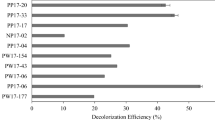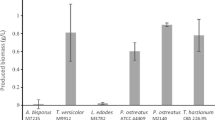Abstract
A strict screening strategy for microorganism selection was followed employing a number of white-rot fungi for the bioremediation of textile effluent, which was generated from one Ireland-based American textile industry. Finally, one fungus Bjerkandera adusta has been investigated in depth for its ability to simultaneously degrade and enrich the nutritional quality of highly coloured textile effluent-adsorbed barley husks through solid-state fermentation (SSF). Certain important parameters such as media requirements, moisture content, protein/biomass production and enzyme activities were examined in detail. A previously optimised method of dye desorption was employed to measure the extent of dye remediation through effluent decolorisation achieved as a result of fungal activity in SSF. B. adusta was capable of decolourising a considerable concentration of the synthetic dye effluent (up to 53%) with a moisture content of 80–85%. Protein enrichment of the fermented mass was achieved to the extent of 229 g/kg dry weight initial substrate used. Lignin peroxidase and laccase were found to be the two main enzymes produced during SSF of the dye-adsorbed lignocellulosic waste residue.






Similar content being viewed by others
References
Banat, I. M., Nigam, P., Singh, D., & Marchant, R. (1996). Bioresource Technology, 58, 217–227. DOI 10.1016/S0960-8524(96)00113-7.
Kirby, N. (1999). PhD Thesis, University of Ulster, Coleraine, Northern Ireland.
Paszczynski, A., & Crawford, R. C. (1995). Biotechnology Progress, 11, 368–379. DOI 10.1021/bp00034a002.
Nigam, P., Armour, G., Banat, I. M., Singh, D., & Marchant, R. (2000). Bioresource Technology, 72, 219–226. DOI 10.1016/S0960-8524(99)00123-6.
Nigam, P., & Singh, D. (1994). Journal of Basic Microbiology, 34, 405–423. DOI 10.1002/jobm.3620340607.
Balakrishnan, K., & Pandey, A. (1996). Journal of Scientific and Industrial Research, 55, 365–372.
Durand, A., Almanza, S., Renaud, R., & Maratray, J. (1997). Agro Food Industry Hi-tech, 8, 39–42.
Mitchell, D. A., & Lonsane, B. K. (1992). Solid Substrate Cultivation. In H.W. Doelle, D. A. Mitchell, & C.E. Rolz (Eds.), Elsevier, Essex, England.
Bhumiratana, A., Flegel, T., Glinsukon, T., & Somporan, W. (1980). Applied and Environmental Microbiology, 39, 425–430.
Hesseltine, C. W. (1983). Annual Review of Microbiology, 37, 575–601. DOI 10.1146/annurev.mi.37.100183.003043.
GumbinaSaid, E. (1996). Journal of Scientific and Industrial Research, 55, 431–438.
Nigam, P., & Singh, D. (1996a). Journal of Scientific and Industrial Research, 55, 373–380.
Sandhu, D. K., & Joshi, V. K. (1997). Journal of Scientific and Industrial Research, 56, 86–90.
Hinman, N. D., Schell, D. J., Riley, C. J., Bergeron, P. W., & Walter, P. J. (1992). Applied biochemistry and biotechnology, 34–5, 639–649.
Ingram, L. O., Aldrich, H. C., Borges, A. C. C., Causey, T. B., Martinez-Morales, F., Saleh, A., et al. (1999). Bioresource Technology, 15, 855–866. DOI 10.1021/bp9901062.
Lapadatescu, C., & Bonnarme, P. (1999). Biotechnology Letters, 21, 763–769. DOI 10.1023/A:1005527205998.
Gombert, A. K., Pinto, A. L., Castilho, L. R., & Freire, D. M. G. (1999). Proceedings of Biochemistry, 35, 85–90. DOI 10.1016/S0032-9592(99)00036-9.
Nigam, P., & Singh, D. (1996b). Journal of Scientific and Industrial Research, 55, 457–467.
Robinson, T., McMullan, G., Marchant, R., & Nigam, P. (2001). Bioresource Technology, 77, 247–255. DOI 10.1016/S0960-8524(00)00080-8.
Makkar, R. S., & Cameotra, S. S. (1999). Journal of Surfactants and Detergents, 2, 237–241. DOI 10.1007/s11743-999-0078-3.
Pandey, A., Soccol, C. R., & Mithchell, D. (2000). Process Biochemistry, 35, 1153–1169.
Palmqvist, E., & Hahn-Hagerdal, B. (2000). Bioresource Technology, 74, 17–24. DOI 10.1016/S0960-8524(99)00160-1.
Robinson, T., Chandran, B., & Nigam, P. (2002a). Environment International, 28, 29–33. DOI 10.1016/S0160-4120(01)00131-3.
Robinson, T., Chandran, B., & Nigam, P. (2002b). Bioresource Technology, 84, 299–301. DOI 10.1016/S0960-8524(02)00039-1.
Robinson, T., Chandran, B., & Nigam, P. (2002c). Applied Biochemistry and Biotechnology, 7, 810–813.
Robinson, T., Chandran, B., & Nigam, P. (2002d). Enzyme and Microbial Technology, 29, 575–579. DOI 10.1016/S0141-0229(01)00430-6.
Gupte, A., & Madamwar, D. (1996). Applied biochemistry and biotechnology, 62, 267–273. DOI 10.1007/BF02788002.
Nigam, P. (1994). Process Biochemistry, 29, 337–342. DOI 10.1016/0032-9592(94)87002-0.
Brand, D., Pandey, A., Roussos, S., & Soccol, C. R. (2000). Enzyme and Microbial Technology, 27, 127–133. DOI 10.1016/S0141-0229(00)00186-1.
Bhatt, M., Patel, M., Rawal, B., Novotny, C., Molitoris, H. P., & Sasek, V. (2000). World Journal of Microbiology & Biotechnology, 16, 195–198. DOI 10.1023/A:1008937503675.
Herbert, D. P., Phipps P. J, & Strange, R. E. (1971). Methods in Microbiology. In J. R. Norris, & D. W. Ribbons (Eds.). London: Academic Press, pp. 209–344.
Bollag, J. M., Chen, C. M., Sarkar, J. M., & Loll, M. J. (1987). Soil Biology & Biochemistry, 19, 61–67. DOI 10.1016/0038-0717(87)90126-X.
Tien, M., & Kirk, T. K. (1988). Methods in Enzymology, 161, 238–249. DOI 10.1016/0076-6879(88)61025-1.
Author information
Authors and Affiliations
Corresponding author
Rights and permissions
About this article
Cite this article
Robinson, T., Nigam, P.S. Remediation of Textile Dye Waste Water Using a White-Rot Fungus Bjerkandera adusta Through Solid-state Fermentation (SSF). Appl Biochem Biotechnol 151, 618–628 (2008). https://doi.org/10.1007/s12010-008-8272-6
Received:
Accepted:
Published:
Issue Date:
DOI: https://doi.org/10.1007/s12010-008-8272-6




